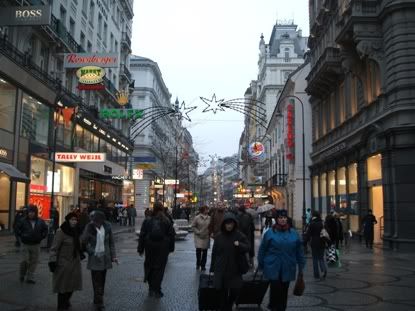Confectionary conflict in Vienna
The only other time I visited this country was on a day trip to
Coming off an early train from
Immediately noticeable as I walked from Vienna Südbahnhof towards the city centre were the red and white poles leaning off walls of tall buildings a few feet into the pavement. These are there as warnings for people not to walk too close, since roof avalanches can be fatal for nearby pedestrians. Although heavy snowfall is apparently quite rare for

There were some wonderful wide pedestrian streets, which contained all the usual suspects in terms of shopping possibilities. It definitely felt like being back in the west of Europe and one obvious clue was the sinful omnipresence of Starbucks coffeehouses; they're incredibly popular nearly everywhere in
Security was very high in general, since
We met at the Café Schwarzenburg. I can't decide if that place was luxuriously sophisticated or pretentiously overelaborate. Uniform for the male waiters was bow tie and waistcoat, for example, but on the other hand, paintings on the walls were on sale. Quite a strange contrast. But Austrians are famed for their love of the café culture, so I suppose it makes sense for such places to exist in
This brings me to one of the weirdest pieces of Austrian history, maybe even on a global level in terms of bizarreness. I read in a travel book some months ago about the famous Sachertorte, a gourmet cake with a past riddled in conflict. This dry chocolate confection, with flavourings of apricot and usually served with cream, was first created by trainee chef Franz Sacher in 1832. Prince Metternich had demanded his private kitchen to produce a new dessert for an important dinner party and chaos ensued because the head chef was ill in bed. Responsibility ended up with 16-year-old apprentice Sacher and he produced the masterpiece from restricted resources.
After that he went on to open a Hotel in his name, which became famous for this cake and many other delicacies. The dispute arose when, for unknown reasons, his son decided to sell the recipe to the Demel pastry shop, another leading Viennese culinary institution. The Hotel Sacher and Demel soon entered a bitter struggle over who had the right to name their cake “Sachertorte”. Following an astonishing nine-year legal battle, in 1962 it was ruled the Hotel Sacher would name its version the “original Sachertorte”, with Demel taking “original Demel Sachertorte”.
Seems like a good compromise to me. But just think about it: a national dispute over the name of a confectionary product lasting all this time. It was only the court case that went on for nine years, people were arguing about it since long before then and probably still do. They definitely seem to like talking about it very much; after I asked the Scharzenburg waiter about the Sachertorte history and received an unexpected answer about ingredients, a local approached and excitedly enquired “Do you speak English?” before narrating the tale to me with all its fine intricacies.
So I suppose that was the highlight of my day (by the way, the cake was really good, if not a little overpriced). Despite the cold I still enjoyed walking the streets of





0 Comments:
Post a Comment
<< Home